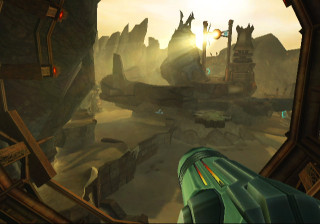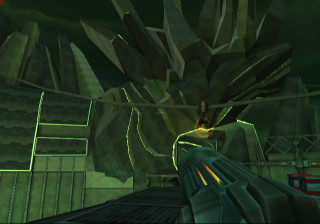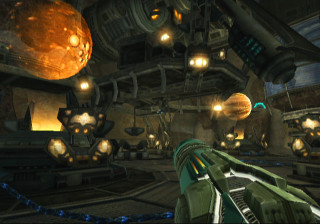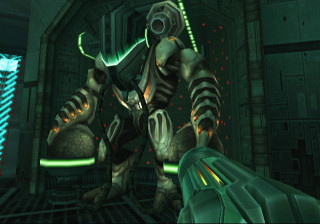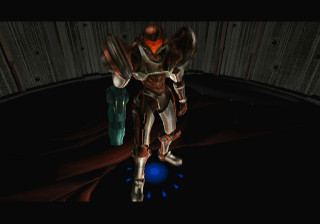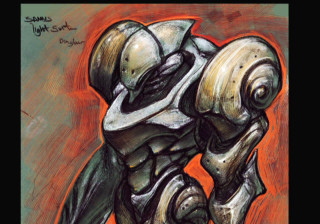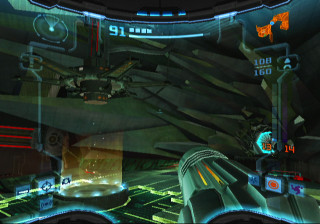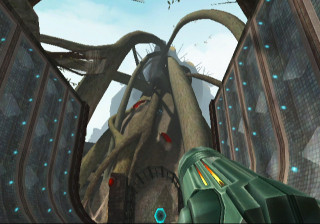I’ve already mentioned how hugely impressed I was (and still am) with the two Metroid Prime games. The first game was an amazingly finely crafted statement of intent by Retro Studios, which had the benefit of a long development period during which to hone the level design and smooth out any wrinkles in the difficulty curve. It set a new watermark for the level of attention to detail that could be indulged in a ‘next-gen’ game.
The second game ups the ante in many departments – the game world is larger and more organic, the visuals (especially the creature design) are greatly improved, and the platforming features (the Morph Ball systems, grappling hook, space jump, shinespark, etc.) are integrated much more seamlessly into the game environment.
However, Retro seemed to have designed the second game with players who completed the original title in mind, which is a nice way of saying that they seriously unbalanced the difficulty curve. There are a handful of boss battles in the game that act as chokepoints, preventing any progress from being made until they are completed. These bosses are brutally difficult to beat, a situation that is not aided by the fact that they’re early enough in the game that there aren’t enough upgrades available to cushion players who prefer platforming and exploration to performing marathon feats of manual dexterity. Sections of the game such as the Spider Guardian caused me to stop playing entirely for an extended period of time, frustrated by the fact that I was failing at my entertainment.
The compressed development schedule is apparent, not in the form of bugs or obvious rough edges, but in the diminished degree to which everything in the game seems to have been thought through. For instance, there are at least seven distinct factions present on Aether, with little rhyme or reason as to why they’re there beyond the initial plot setup. There is none of MP1’s gradual development of story through journal entries to be found here.
For those who managed to stick through the gruelling early sections, the final third of the game is much more rewarding. The player gets to thoroughly explore the Tron-like Forsaken Fortress and the mirror-world of Dark Aether, environments that are a bigger departure from Metroid Prime 1’s blueprint than what goes before. With most of Samus’s toys now available, the player is able to take in the lush scenery at a more leisurely pace. The light/dark ammunition system becomes less of a hinderance and a boatload of secret areas and morph ball mazes become accessible.
I remain unconvinced that Metroid Prime 2, even with it’s radical turnaround in the latter stages and richer (and longer) overall game experience, is a better game than the first. With a longer development time and more judicious editing and play balancing, the game could have been a clear improvement on the original in all aspects, but realistically I suppose the game had to be released before the GameCube’s life cycle began to wind down.
That aside, I am convinced that Metroid Prime 2 is an exceptionally beautiful and atmospheric game which deserves to be appreciated by more people. To that end, I’ve put together a gallery of screenshots showcasing many of the impressive sights that the planet Aether has to offer. Be warned that most of these were taken towards the end of the game, so if you’re paranoid about spoilers, look away now.
The rest of the screens can be found here.
All these screenshots were taken directly from the GameCube’s external frame buffer with the aid of a broadband adapter, Datel’s Max Drive Pro and Parasyte’s excellent GameCube remote debugger tool, GCNrd 1.0. The colours were then adjusted in an attempt to get a better approximation of the GameCube’s TV output (the rawcaps look a little washed out when displayed on a monitor).
Metroid Prime 2: Echoes and all imagery therein is copyright Nintendo, natch.
Tags: gallery, Game, game title, gamecube, metroid prime 2 echoes, nintendo, retro studios, screenshots

